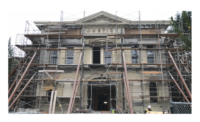Located at 45 Main St E in Hamilton, Ontario, it was built in 1935 - but a half-century before that, a spectacular post office had been built on the same spot. It was an impressive red stone building featuring a clock tower and cornices. It was during the Depression when the Canadian government came up with the “Dominion Government Construction Programme of Recovery.”
They decided Hamilton would get a new post office, with space also for customs, marine, agriculture, immigration and tax offices. The original building was mostly demolished, and in September 1936, the new, $1.6 million Dominion Public Building opened to the public.
This post office is now part of the renamed John Sopinka Courthouse. The old marble hall with the postal wickets and large tables still exists on the ground floor of the building. a+LiNK Architecture was retained and provided specialized knowledge to preserve the cultural heritage of the John Sopinka Courthouse by Infrastructure Ontario. They provided an investigation, analysis and proposed solution for the stone façade restoration of the historic courthouse. The restoration included repairs and re-attachment to five stories of stone on the building envelope, original masonry components and the metal canopy. With this analysis, it was determined that the original ties were loose, deteriorated and failing.
The Cintec Reinforcement System was used to re-attach the stone to the diverse brick and/or speed tile (structural terra cotta) back-up wall. The fact that the Cintec anchors attached both adhesively and mechanically, which provided progressive failure as opposed to brittle fracture, as well as the inherent fireproof capability, was a strong consideration.
However, the back-up wall capacity was still of concern. To this end, extensive and successful testing was conducted. Because the bulbing action (mechanical attachment) of the Cintec system distributed required loads over much larger areas than other systems, the fragile back-up walls were able to withstand required loads - including wind load. A 3/8-inch (10-millimeter) threaded rod with 1 1/4-inch (32-millimeter) sock, 7 1/2 inches (190 millimeters) long, socked 6 inches (150 millimeters) in a 1 1/4-inch (32-millimeter) hole was used. Over 700 anchors were used to re-attach the stone and were installed by Phoenix Restoration of Whitby, Ontario.





Report Abusive Comment